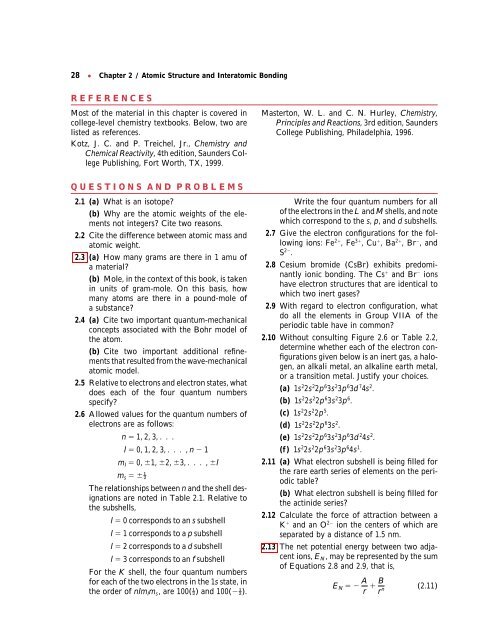Chapter 2 / Atomic Structure and Interatomic Bonding
Chapter 2 / Atomic Structure and Interatomic Bonding
Chapter 2 / Atomic Structure and Interatomic Bonding
Create successful ePaper yourself
Turn your PDF publications into a flip-book with our unique Google optimized e-Paper software.
28 ● <strong>Chapter</strong> 2 / <strong>Atomic</strong> <strong>Structure</strong> <strong>and</strong> <strong>Interatomic</strong> <strong>Bonding</strong><br />
REFERENCES<br />
Most of the material in this chapter is covered in<br />
college-level chemistry textbooks. Below, two are<br />
listed as references.<br />
Kotz, J. C. <strong>and</strong> P. Treichel, Jr., Chemistry <strong>and</strong><br />
Chemical Reactivity, 4th edition, Saunders College<br />
Publishing, Fort Worth, TX, 1999.<br />
QUESTIONS AND PROBLEMS<br />
2.1 (a) What is an isotope?<br />
(b) Why are the atomic weights of the elements<br />
not integers? Cite two reasons.<br />
2.2 Cite the difference between atomic mass <strong>and</strong><br />
atomic weight.<br />
2.3 (a) How many grams are there in 1 amu of<br />
a material?<br />
(b) Mole, in the context of this book, is taken<br />
in units of gram-mole. On this basis, how<br />
many atoms are there in a pound-mole of<br />
a substance?<br />
2.4 (a) Cite two important quantum-mechanical<br />
concepts associated with the Bohr model of<br />
the atom.<br />
(b) Cite two important additional refinements<br />
that resulted from the wave-mechanical<br />
atomic model.<br />
2.5 Relative to electrons <strong>and</strong> electron states, what<br />
does each of the four quantum numbers<br />
specify?<br />
2.6 Allowed values for the quantum numbers of<br />
electrons are as follows:<br />
n 1, 2, 3, . . .<br />
l 0,1,2,3,...,n 1<br />
ml 0, 1, 2, 3,...,l<br />
ms <br />
The relationships between n <strong>and</strong> the shell designations<br />
are noted in Table 2.1. Relative to<br />
the subshells,<br />
l 0 corresponds to an s subshell<br />
l 1 corresponds to a p subshell<br />
l 2 corresponds to a d subshell<br />
l 3 corresponds to an f subshell<br />
For the K shell, the four quantum numbers<br />
for each of the two electrons in the 1s state, in<br />
the order of nlmlms, are 100() <strong>and</strong> 100().<br />
Masterton, W. L. <strong>and</strong> C. N. Hurley, Chemistry,<br />
Principles <strong>and</strong> Reactions, 3rd edition, Saunders<br />
College Publishing, Philadelphia, 1996.<br />
Write the four quantum numbers for all<br />
of the electrons in the L <strong>and</strong> M shells, <strong>and</strong> note<br />
which correspond to the s, p, <strong>and</strong> d subshells.<br />
2.7 Give the electron configurations for the following<br />
ions: Fe 2 ,Fe 3 ,Cu ,Ba 2 ,Br , <strong>and</strong><br />
S 2 .<br />
2.8 Cesium bromide (CsBr) exhibits predominantly<br />
ionic bonding. The Cs <strong>and</strong> Br ions<br />
have electron structures that are identical to<br />
which two inert gases?<br />
2.9 With regard to electron configuration, what<br />
do all the elements in Group VIIA of the<br />
periodic table have in common?<br />
2.10 Without consulting Figure 2.6 or Table 2.2,<br />
determine whether each of the electron configurations<br />
given below is an inert gas, a halogen,<br />
an alkali metal, an alkaline earth metal,<br />
or a transition metal. Justify your choices.<br />
(a) 1s22s 22p63s 23p63d 74s2 .<br />
(b) 1s22s 22p63s 23p6 .<br />
(c) 1s22s 22p5 .<br />
(d) 1s22s 22p63s 2 .<br />
(e) 1s22s 22p63s 23p63d 24s2 .<br />
(f) 1s22s 22p63s 23p64s 1 .<br />
2.11 (a) What electron subshell is being filled for<br />
the rare earth series of elements on the periodic<br />
table?<br />
(b) What electron subshell is being filled for<br />
the actinide series?<br />
2.12 Calculate the force of attraction between a<br />
K <strong>and</strong> an O 2 ion the centers of which are<br />
separated by a distance of 1.5 nm.<br />
2.13 The net potential energy between two adjacent<br />
ions, EN, may be represented by the sum<br />
of Equations 2.8 <strong>and</strong> 2.9, that is,<br />
EN A B<br />
<br />
r rn (2.11)



